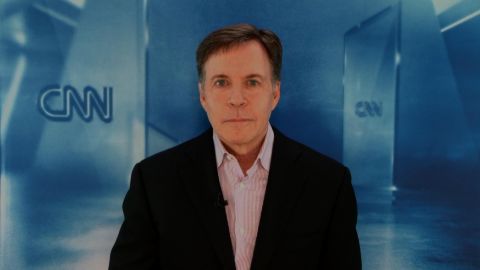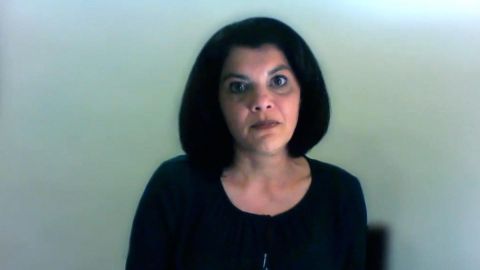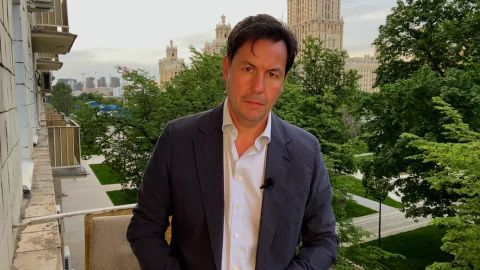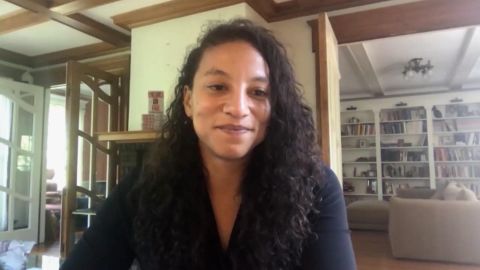Read Transcript EXPAND
BIANNA GOLODRYGA: And we return now to the issue of systemic racism in America and widespread protests we saw in the wake of George Floyd’s death. Our
next guest aims to put the current racial justice movement in context. Elizabeth Hinton is an associate professor of history in African-American
studies at Yale University. Her new book, “America on Fire,” looks at black rebellion in the1960s and ’70s. Here she is talking to Michel Martin about
how we got to where we are today.
(BEGIN VIDEO CLIP)
MICHEL MARTIN: Thanks, Bianna. Professor Elizabeth Hinton, thank you so much for talking with us.
ELIZABETH HINTON, AUTHOR, “AMERICA OF FIRE”: Thank you for having me, Michel.
MARTIN: You know, this is a deeply researched, dense at times work of scholarship, but there is a central argument, which I think many people
will find provocative. Your argument is that this country has a history of mob violence, mainly directed against black people, the Tulsa massacre,
which many people are acknowledging in the coming weeks being a prime example of that. You say that it was only viewed as criminal violence, as
riots when black people started fighting back.
And you further argue that the roots of the kinds of incidents of collective violence that we see today, like the enormous demonstrations
we’ve seen at recent years are actually a response to abuses by police and other governmental authorities who refuse to respond appropriately to
legitimate grievances. And you say these are, in many ways, the aftershocks of the ’60s. What led you to this insight?
HINTON: Well, you know, part of — I had, in my research, been really interested in urban violence, and the relationship between the violence
that emerged in every single — during every summer of Lyndon Johnson’s presidency, and the response to that violence, right, the urban unrest,
beginning with Harlem in 1964 and kind of crescendoing with the 130 some uprisings that emerged after the assassination of Martin Luther King Jr.
And beginnings of the federal law enforcement program during in this period was very in response to threat of this violence.
And at the same time, there were all these questions about how to address racial discrimination and what kinds of social programs would actually
effectively get at the root causes of this violence. And ultimately, the federal policymakers led local and state governments and taking the wrong
policy turn, that is embracing policing and surveillance and incarceration as a short-term solution that ended up becoming long-term reality when the
social programs of the war on poverty became disinvested from.
MARTIN: So, you said the urban riots of the 1960s can only be properly understood as rebellions as sustained insurgency. You said they could only
be understood that way. Why do you say that?
HINTON: So, when Harlem erupted in 1964 in response to killing by a New York police officer of a 15-year-old high school student, Johnson responded
to the violence saying, well, this has nothing to do with civil rights at all. This is nothing other than criminal senseless violence that’s related
to other juvenile delinquency problems and it’s a riot, pure and simple.
But what happened in Harlem and what happened in hundreds of other cities throughout Johnson’s presidency and then thousands after is that the lack
of jobs, the lack of access to socioeconomic resources, substandard housing with roaches and rats running through people’s apartments, this is what
brought people out into the streets in both examples of political violence, but nonviolent direct action protests that guided the civil rights
movement.
So, Johnson and others refused to see the political violence that we see emerging from the mid-1960s onwards is very much part of the same shared
set of socioeconomic grievances of the mainstream civil rights movements. These were the root demands. And so, the socioeconomic inequalities behind
them were the root causes of the rebellions.
Most were tipped off, however, by the most tangible expression of systemic racism, and that is police violence. So, you know, all of — nearly all of
the rebellions that we see, beginning in the ’60s but lasting through today, are in response to a moment of police violence.
MARTIN: One of these that I found really fascinating about the book is you say that, you know, people focus on lots, they focus on Detroit, they focus
on D.C., they focus on Newark. But you say that smaller cities are more important in understanding this than major urban centers.
So, first of all, why is that? And secondly, can you give us an example of why you say that?
HINTON: So, we have to — you know, one of the things we all — I think many historians and scholars in the public missed due to focus on large
scale disorders in big cities during the Johnson administration is that the real peak of urban rebellion occurred actually after Martin Luther King’s
assassination, after the Omnibus Crime Control and Safe Streets was enacted in June19’68, which launched the war on crime.
The kind of early war on crime during the first — from ’65 to ’68, you know, brought new military grade weapons to police departments in Chicago,
in D.C., New York, the big cities that we think about, the big cities that experienced unrest and Detroit, right, they funded expansion of those
police forces in major metropolitan centers.
But when the federal government passes the first piece of major national crime control legislation in 1968, allowing state governments and local
governments to also, you know, increase their weapons arsenal with surplus guns and armored tanks and helicopters from Vietnam and expand their police
forces as well, residents in smaller rural and mid-size cities reacted to these new policing strategies in much the same way as their big city
counterparts did.
And so, understanding that, you know, the urban rebellions were not just a phenomenon of big cities or archetypal ghettos that we may think of, but
actually, this is a thoroughly American phenomenon that occurred in nearly every city where black Americans lived and segregated unequal conditions in
the late 1960s and 1970s. it helps us understand that, you know, this wasn’t just a northern phenomenon.
MARTIN: Could you just pick one of these smaller cities and talk about what happened there and why you say this is so much a part of this pattern
that we don’t talk about?
HINTON: What we saw in cities like Cairo and York were particularly devastating incidents of rebellion. In part — you know, and York was —
for a city of its size, arguably the most destructive rebellion of the late ’60s and ’70s. And the rebellion in Cairo essentially lasted from 1969 to
1972, and that is in part because white vigilante groups in both cities were deeply, deeply entwined with the police force.
And so, black residents in both cities were essentially being terrorized by white mobs and had no recourse and no protection from the police
department. So, had no choice but to fight back. And when they began to fight back from violence they were experiencing, the police fought back
with even more and legitimate force leading to days of property destruction, deaths in some cases and violent rebellion on both sides.
MARTIN: And just to clarify, OK, we’re not talking about the ’20s or ’30s or the reconstruction era, 1890s, you know, we’re talking about the ’60s.
HINTON: That’s what’s so shocking to me, especially, you know, when I uncovered the stories in York and Cairo. It’s shocking that this kind of
white supremacist violence was being inflicted in such blatant and devastating ways in the late 60s and early 1970s. I mean, that, you know,
to me was somewhat surprising.
MARTIN: Why is it so important to call these events rebellions and not riots? I mean, why does — why do you think the nomenclature mattered then
and why do you think it matters now?
HINTON: Terminology here really matters because if we continue to use the term riot to describe these incidents of political violence, we’re never
going to get out of the cycle. That is if these incidents of political violence are seen as meaningless and criminal, even though they’re rooted
in these larger socioeconomic demands, then the only response to the political violence is more police, which is, you know, the precipitating
cause of the rebellions in the first place.
And so, the term riot itself is not going to allow us to get out of the cycle of police and community violence that we have been trapped in in many
respects ever since the civil rights movement.
MARTIN: You said that black rebellion was a self-fulfilling prophesy, a menace that would persist as long as state violence was used to preserve
racial hierarchy. But I want to ask you if there has ever been a point where this cycle could have been interrupted?
I mean, you documented a number of instances where high-level commissions, like Kerner Commission, I mean, people might remember that after the 1968
uprisings. You point to many white political leaders who have said, we don’t condone the destruction, we don’t condone, you know, the violence,
but this is a response to real grievances.
And so, you point out that there have been a number of instances where that’s occurred. So, was there a point where you think this cycle could
have been interrupted? And why do you think it hasn’t been?
HINTON: So, that’s one of the real missed — that’s kind of the tragedy of the book, right? I mean, all of these missed opportunities when
alternatives to responding to the problems of poverty and inequality with police were presented to policy makers and yet, they refused to get out of
that policing paradigm, that solution that police are, you know, the only institution that can be implemented to manage the fundamental socioeconomic
inequalities in our society.
So, you know, the Kerner Commission in 1968 is one major missed opportunity which Johnson calls in the middle of the rebellion of Detroit in ’67 and
instructs them to evaluate the causes and solutions to urban unrest that had rocked the nation during his presidency.
And the Kerner Commission said, if we really want to address the root causes of the riots, as they called them, then we need a massive infusion
of resources into black communities. We need a job creation program, we need better schools, we need better housing programs. The war on poverty
hasn’t gone far enough.
And as rebellion continued at the state and local level, commissions also, you know, came in after incidents and violence and had recommended many of
the same things from Harrisburg, Pennsylvania to Cairo, the city I was just talking about, came in and said, OK, these are all of the structural root
causes of this violence. And so, we need to put in the resources and we need to have the political will to address it. And yet, these calls for
structural transformation, one that went outside of the police as a solution were never embraced.
MARTIN: Well, what you are describing sounds a lot like what is happening — a debate that is happening now, you know, in response to the massive,
you know, demonstrations, protests, overwhelmingly peaceful. I mean, some of them did devolved into sort of violence and property destruction, but in
response to the killing of George Floyd last year, there have been these kinds of discussions. But you’re also seeing and — which is sort of
commonly summarized as movement to defund the police, but you also see varying visceral kind of counter action to that, and some are arguing that,
no, this is just lawlessness and this has to be addressed.
Do you see the current moment as an opportunity to revisit the way we respond to these incidents of communal violence?
HINTON: I think the current moment reflects the consequences, and the fact that we have never invested in that — in those systemic solutions that
have been on the table now more than a half century. You know, had we addressed those root causes, people wouldn’t be in the streets now.
And at this point, you know, some 50 years later, when the U.S. has become a mass incarceration society and policing in prison and surveillance have
been embraced as the foremost policy responses to inequality have been embraced as the only public safety paradigm when community-based safety
measures we know are cost effective and work far better.
And now, we need a different set of investments and now, we need a different set of policy approaches. For me, that’s what things like defund
the police are about. That’s what much of the racial justice protests are calling into question, those misguided priorities that see only punitive
policies and punitive programs as a solution.
MARTIN: But I feel like I have an obligation to the part of our audience that doesn’t think that. I mean, you speak to that in the book. You point
out it could be difficult to imagine children and teenagers who threw rocks at police or who looted local businesses as political actors. You can see
why many people would say, how is stealing bras and sneakers from Target or stealing jewelry from some small business guy, you know, from Pakistan in
Queens, how is that a political statement?
HINTON: Well, those actions from, you know, responding to police violence by returning with rocks and bottles to taking essential goods from stores,
to me is, again, and to many of the people who participated from the 1960s and today themselves, you know, about a statement rooted in fundamental
inequalities when justice seems like it is impossible, when one’s only option after decades and years of nonviolent protest is to take violent
action.
I mean, they think one thing that’s really key is that in every single city where rebellion occurred, residents had for years embraced steps of
nonviolent direct-action protests, they had taken to the streets in peaceful marches, they had written to their local elected officials and
petitioned them to change certain laws and to make it more inclusive and expansive set of policies for a city. They had filed lawsuits, and none of
this had worked.
And this is part of the reason why people felt like the only — at that point, the only tool they had was to fight back. And I think it’s also
really important to note that most of the protests that we witnessed over the summer of 2020 were peaceful, but one of the really key distinctions
between the uprisings that we began to see resurge in 2014 and 2015 is that all of these started out peacefully, you know, from Ferguson in 2014 to
Minneapolis in 2020, they started out peacefully, they started as nonviolent demonstrations and then police came in and responded to that
peaceful protest with tear gas and with beating people with their Billy clubs and with mace and violence.
And the protesters, the peaceful protesters in turn responded to that police violence with violence. And this is the cycle of police and
community violence that I write about in the book that we have seen playing out since the 1960s.
MARTIN: It seems to me that some of the polling indicates that even, you know, African-Americans in response to ongoing instability sometimes begin
to favor even more police response. Do you think that that’s true?
HINTON: Well, this is actually something that I have thought about a lot and written about with my colleagues, Vesla Weaver and Julilly Kohler-
Hausmann. And we call this concept selective hearing. So, of course, people who are living in communities that are suffering from high rates of crime
and social harm or violence want to have safe communities. That’s basic.
But when black people call for better policing, instead, elected officials, policymakers hear more policing. They’re not actually listening to the
range of things that black people are demanding. They’re not just calling for policing, they’re also calling for the same things, many of the same
things that people who are in the streets both violently and nonviolently are. They’re calling for better schools. They’re calling for more job
opportunities. They’re calling for different sets of investments in the community beyond the police.
And one of the questions is, you know, of all of the demands that black Americans have made on the state from the ’60s onwards, most of them, you
know, rooted in socioeconomic issues. Why is it that the only thing they have gotten are calls for police, are the calls for harsher sentences, are
the punitive things they asked for? And that’s what this selective — that’s the concept of selective hearing is really about.
MARTIN: Professor Elizabeth Hinton, thank you so much for joining us.
HINTON: Thank you for having me.
About This Episode EXPAND
Karen Bass; Matthew Chance; Tamara Alrifai; Bob Costas; Elizabeth Hinton
LEARN MORE




